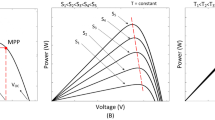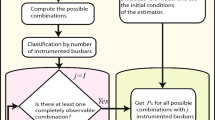Abstract
This paper presents a digital predistorter to linearize the High Power Amplifier (HPA) with memory effect. The proposed predistorter is based on the approach of Multi-Level 2D LUT based model that compensate the HPA distortion based on memory and non-linearity. The Multi-Level approach utilized in the proposed system eliminates the trade-off between accuracy and adaptation speed. The proposed model is validated by utilizing the Orthogonal Frequency Division Multiplexing of Digital Video Broadcasting-Terrestrial. The Matlab realization of the proposed system show 33X–35X faster convergence time than predistorter based on conventional 2D-LUT model with same adaptation step and memory size.




Similar content being viewed by others
References
Digital Audio Broadcasting (DAB). (2001). Guidelines and rules for implementation and operation: Part I, II and III. ETSI TR 101 Technical report, 496–1, 2, 3 (1.1.1).
Digital Video Broadcasting (DVB). (2004). Implementation guidelines for DVB terrestrial services: Transmission aspects. ETSI TR 101Technical report, 190 (1.2.1).
IEEE Standard for Local and Metropolitan Area Networks Part 16: Air Interface for Fixed and Mobile Broadband Wireless Access Systems. Amendment 2: Physical and Medium Access Control Layers for Combined Fixed and Mobile Operation in Licensed Bands and Corrigendum 1, IEEE 802.16e-2005Technical report, (2005).
Tellado, J. (1999). Peak-to-average power reduction, Ph.D. thesis, Stanford University.
Jayalath, A. D. S., & Tellambura, C. (2005). SLM and PTS peak-power reduction of OFDM signals without side information. IEEE Transactions on Wireless Communications, 4(5), 2006–2013.
Breiling, M., Muller-Weinfurtner, S. H., & Huber, J. B. (2001). SLM peak power reduction without explicit side information. IEEE Communications Letters, 5(6), 239–241.
Jayalath, A. D. S., & Tellambura, C. (2000). Reducing the peak-to-average power ratio of orthogonal frequency division multiplexing signal through bit or symbol interleaving. IEE Electronics Letters, 36(13), 1161–1163.
Fischer, R. F. H., & Siegl, C. (2009). Reed-Solomon and simplex codes for peak-to-average power ratio reduction in OFDM. IEEE Transactions on Information Theory, 55(4), 1519–1528.
Jiménez, V. P. G., Fernández-Getino García, M. J., Sánchez Fernández, M. P., & Armada, A. G. (2008). Efficient implementation of complementary Golay sequences for PAR reduction and forward error correction in OFDM-based WLAN systems. AEÜ-International Journal of Electronics Communications, 62(9), 683–694.
Li, X., & Cimini, L. J. (1998). Effect of clipping and filtering on the performance of OFDM. IEEE Communications Letters, 2(5), 131–133.
Jabrane, Y., Jiménez, V. P. G., Armada, A. G., Ait Es Said, B., & Ait Ouahman, A., (2009). Reduction of the envelope fluctuations of multi-carrier modulations using neural fuzzy systems. IEEE Transactions on Communications, 59(1), 19–25
Wilich, D., Dinur, N., & Glinowiecki, A. (2000). Level clipped high-order OFDM. IEEE Transactions on Communications, 48(6), 928–930.
Swaminathan, J. N., Kumar, P., & Vinoth, M. (2012). Performance Analysis of LMS filter in SSPA linearization in different modulation conditions. In Elsevier conference proceedings ICECIT.
Swaminathan, J. N., Kumar, P., & Vinoth, M. (2012). Performance analysis of LMS filter in linearization of different memoryless non linear power amplifier models. In Springer conference proceedings ICAC3.
Swaminathan, J. N., & Kumar, P. (2013). Design and linearization of solid state power amplifier using pre-distortion technique. In IEEE conference proceedings ICCCI.
Aburakhia, S. A., Badran, E. F., & Mohamed, D. A. E. (2009). Linear companding transform for the reduction of peak-to-average power ratio of OFDM signals. IEEE Transactions on Broadcasting, 55(1), 155–160.
Bo, A., Zhi-xing, Y., Chang-yong, P., Tao-tao, Z., & Jian-hua, G. (2005). Effects of PAPR reduction on HPA predistortion. IEEE Transactions on Consumer Electronics, 51(1), 1143–1147.
Li, J., & Ilow, J. (2006). Adaptive Volterra predistorters for compensation of non-linear effects with memory in OFDM transmitters. In Proceedings of IEEE 4th annual communications and networks services research conference (CNSR), pp. 103–106.
Chen, H.-H., Lin, C.-H., Huang, P.-C., & Chen, J.-T. (2006). “Joint polynomial and look-up-table predistortion power amplifier linearization”, IEEE Trans. Circuits Systems II: Express Briefs, 53(8), 612– 616.
Wang, T., & Ilow, J. (2004). Compensation of nonlinear distortions with memory effects in OFDM transmitters, In Proc. IEEE Global Telecommun. Conf. (GLOBECOM), Dallas, Tex, USA, Dec. 4, 2398–2403.
Cheong, M. Y., Aschbacher, E., Brunmayr, P., & Laakso, T. (2005). Comparison and experimental verification of two low-complex digital predistortion methods. In 39th Asilomar conference on signals, systems and computers.
Yu, C., Liu, Y., & Li, S. (2009). Triangular memory polynomial predistorter, In Proceedings of 5th international conference on wireless communcations and networks, mobile computing. (WiCom), pp. 1–4.
Ding, L., Zhou, G. T., Morgan, D. R., Ma, Z., Kenney, J. S., Kim, J., et al. (2004). A robust digital baseband predistorter constructed using memory polynomials. IEEE Transactions on Communications, 52(1), 159–165.
Nguyen, T. M., Yoh, J., Lee, C. H., Tran, H. T., & Johnson, D. M. (2003). Modeling of HPA and HPA linearization through a predistorter: Global broadcasting service applications. IEEE Transaction on Broadcasting, 49(2), 132–141.
Wesolowski, K. (2005). A novel fast HPA predistorter for high PAPR signals, In Proceedings of IEEE 16th international symposium on Pers., indoor, mobile radio communications (PIMRC) (pp. 863–867). Berlin.
Lei, D., Raich, R., & Zhou, G. T. (2002). A Hammerstein predistortion linearization design based on the indirect learning architecture. In IEEE international conference on acoustics, speech, and signal processing, p. III.
Rawat, M., Rawat, K., & Ghannouchi, F. M. (2010). Adaptive digital predistortion of wireless power amplifier/transmitters using dynamic real-valued focused time-delay line neural networks. IEEE Transactions on Microwave Theory and Techniques, 58(1), 95–104.
Hao, L., Hyan, K. D., Deming, C., & Yun, C. (2009). A fast digital predistortion algorithm for radio-frequency power amplifier linearization with loop delay compensation. IEEE Journal of Selected Topics in Signal Processing, 3(3), 374–383.
He, Z-y, Ge, J-h, Geng, S-j, & Wang, G. (2006). An improved look-up table predistortion technique for HPA with memory effects in OFDM systems. IEEE Transactions on Broadcasting, 52(1), 87–91.
Lei, D., Zhou, G. T., Morgan, D. R., Zhengxiang, M., Kenney, J. S., Jaehyeong, K., et al. (2004). A robust digital baseband predistorter constructed using memory polynomials. IEEE Transactions on Communications, 52(1), 159–195.
Saleh, A. (1981). Frequency-Independent and Frequency-Dependent Nonlinear Models of TWT Amplifiers. IEEE Transactions on Communications, 29(11), 1715–1720.
Cavers, J. K. (1990). Amplifier linearization using a digital pre-distorter with fast adaptation and low memory requirements. IEEE Transactions on Vehicular Technology, 39(4), 374–382.
Rapp, A. (1991). Effects of HPA-nonlinearity on a 4-Dpsk/OFDM-signal for a digital sound broadcasting system. In Proceedings of 2nd European conference on satellite communications, Liege, Belgium, Vol. 2, pp. 179–184.
ETSI, E. (2009–2011). Digital Video Broadcasting (DVB), framing structure, channel coding and modulation for digital terrestrial television, ETSI EN 300 744 VI. 6.1.
Author information
Authors and Affiliations
Corresponding author
Rights and permissions
About this article
Cite this article
Swaminathan, J.N., Kumar, P. Design of Efficient Adaptive Predistorter for Nonlinear High Power Amplifier. Wireless Pers Commun 82, 1085–1093 (2015). https://doi.org/10.1007/s11277-014-2267-0
Published:
Issue Date:
DOI: https://doi.org/10.1007/s11277-014-2267-0




